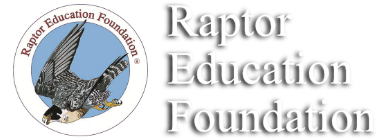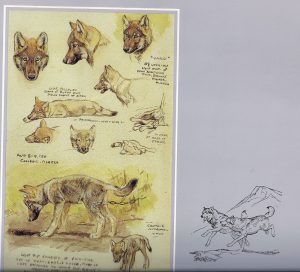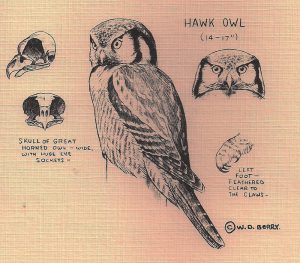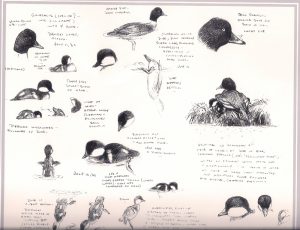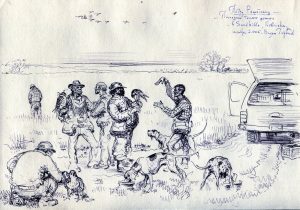Donation, Acquisition, & Evaluation Policies
Traditional Works
Many artists and collectors contact us to donate various types of artworks as a gift to support our work in any way we think will be useful. The information below is provided to acquaint you with our policies for donated works, or authentication and evaluation of collections or individual pieces that feature raptors exclusively or incidentally. Please review this page thoroughly prior to contacting us.
Donations include traditional mediums like oil, watercolor, acrylic, pastel, pencil, or serigraph works. They will also include wood cuts, etchings, or multi-media pieces. Sculptural pieces have been donated in bronze, stainless steel, fired clay, wood carving and so on. Other artists want to contribute photographs, animated pieces, videos or taxidermy specimens. We have even accepted cartoons …see below.
If you are not an artist, collector, or executor and simply wish to donate something with a raptor theme please call our office: 303-680-8500 or email us at raptor2@usaref.org.
We follow a very traditional and historic process in accepting donated pieces. It is the same process we use to commission original work. It is based on peer review by professional artists who are well established in the wildlife art genre. They will include realists or representational artists. They might express themselves as abstract expressionists, cubists, or in any variety of styles, but underlying all their work is a thorough mastery of the species they depict.
Following the practices used by many of the world’s oldest and most respected natural history museums if you are an artist and wish to donate one or more works, please answer the following questions and submit samples of your field sketches as described. Although the field sketches below include mammals, please provide only bird studies, raptors preferably in your submissions. Photographers and videographers are exempted from sending field studies or drawings. If you are a collector or executor, see information below.
- Are you a current or past member of the Society of Animal Artists? Have you been accepted in any of their juried shows? If so, which one(s).
- Have you ever been accepted in any of the shows put on by the Leigh Yawkey Woodson Art Museum? If yes, which year(s)?
- Has your work ever been used to illustrate any natural history publications? If yes, which ones?
- Please submit ten copies of your field studies/sketches created during each of the last five years for a total of 50 examples. If you are a cartoonist, please submit the same quantity of your cartooning examples.
Although the first three questions are important (30%), most weight is placed upon your field studies/life drawings. Learning how to paint, even with great skill, is relatively easy, however, what distinguishes the master wildlife artist since the cave paintings of Lascaux is the artist’s ability to draw. Part of our mission is to promote individual artists who show exceptional skills or potential in capturing the essence of any species, but especially raptors for obvious reasons. Drawing wildlife, especially birds, in living situations is not an easy task, however regular practice hones the skills and talents that we are looking for and will help support. This is the primary principle that guides our choices. Note to artists: If you are tracing or copying photographs, we do not consider that as drawing from life.
The field studies above and below are part of the legacy of William D. Berry of Alaska. Bill’s draughtsmanship of wildlife is legendary. He and some of the other wildlife masters listed below are the guiding star by which our peer reviewers will assess your possible contribution.
An exceptional draughtsman will also be able to produce character studies or animations of any subject they turn their attention to. The study below was produced by Vadim Gorbatov after a day in the field watching falconers flying their birds and working their dogs. Vadim is probably Russia’s best living wildlife artist. He was commissioned by REF to illustrate two children’s books. The piece below took Vadim less than one hour and was executed with a ball point pen! Click on Vadim’s name above to see a larger assortment of his works.
Photographic & Video Submissions
With the advent of rapid self-focusing cameras, we are seeing a tremendous amount of really exceptional wildlife photography and videography. Our bias is towards action studies and behavioral images that have a story associated with them. Please send links to a representative sampling of your work. Please do not send multiple images to our email address.
Taxidermy Works
Exceptional taxidermy work is a rarity, and our current situation precludes us accepting any works in this genre. We will, however, help authenticate and evaluate an individual piece or an entire collection.
Evaluation of Wildlife Art Collections or Individual Pieces: Other Donations.
If you wish us to provide an estimate of value for insurance or estate purposes, or if you wish us to authenticate pieces in your collection, please contact Peter Reshetniak at 303-680-8500. Depending on the content and/or complexity of your collection or individual work of art, a fee may or may not be involved. If you simply wish to donate one or more pieces, we will evaluate them based the principles described above.
Wildlife Artists To Emulate, but Not Copy
Look for any artist from the Animaliers School to begin with. For more recent wildlife artists acquaint yourself with the work by any of the following names: Gerald Balciar, Don Eckelberry, Vadim Gorbatov, Owen Gromme, Francis Lee Jaques, Lars Johnson, Robert Kuhn, Bruno Liljefors, Donald L. Malick, William D. Berry, Louis Agassiz Fuertes, Roger Tory Peterson, Rien Poortvliet, Peter Scott, George Miksch Sutton, Ernest Thompson Seton, William Schultz, Wayne Trimm, Kent Ullberg, Leigh Voigt, Michael Warren.
The preceding list of names does not encompass all the wildlife artists we hold up as examples to guide other artists, however, their work will provide you a comprehensive look at what our peer review team is looking for.
